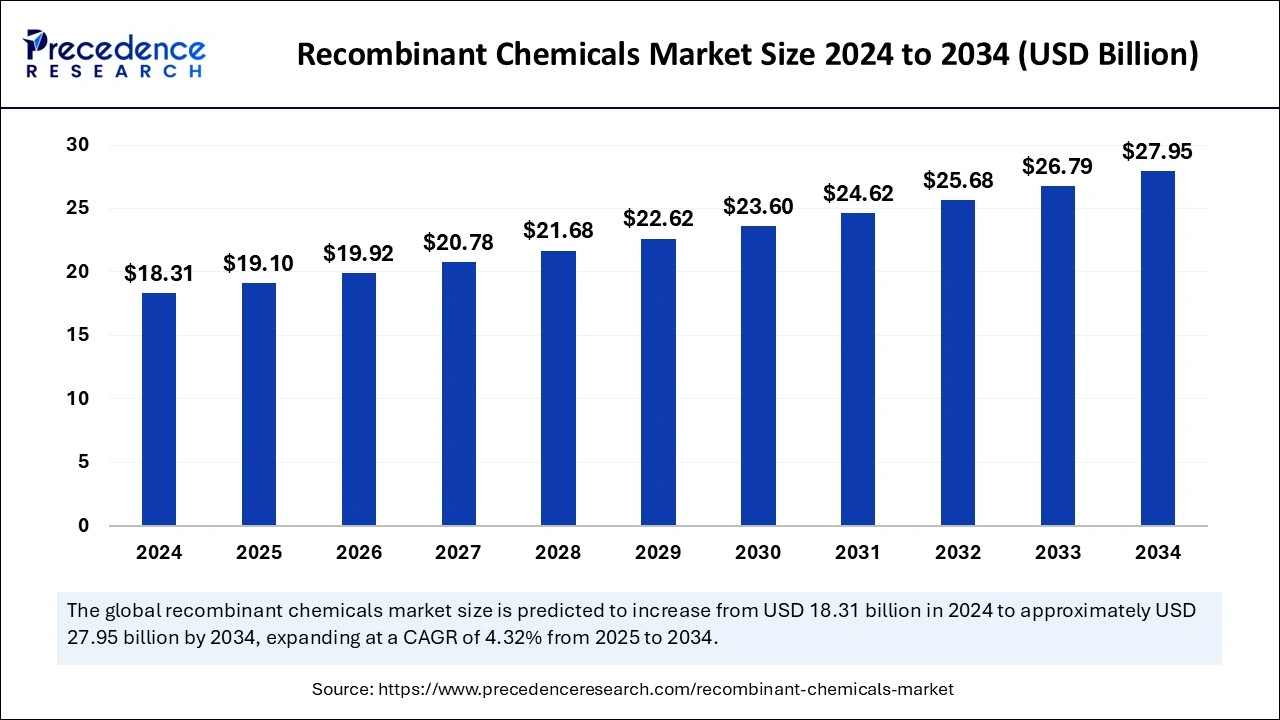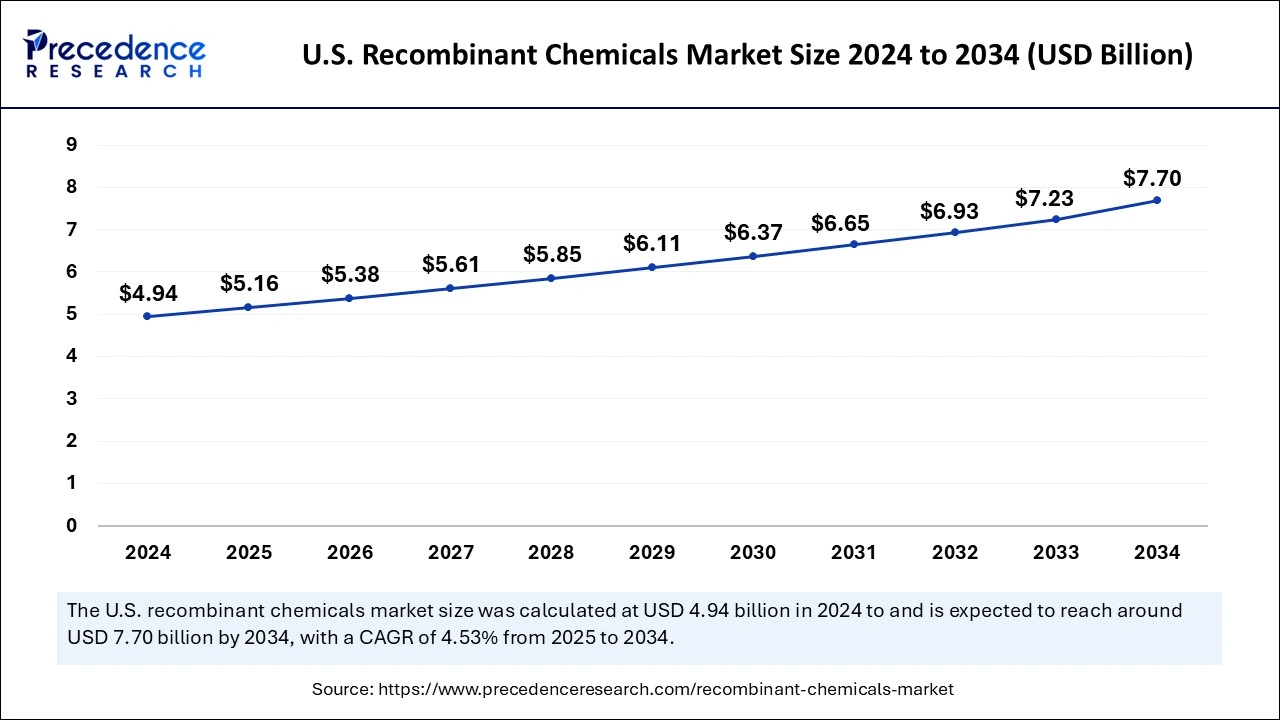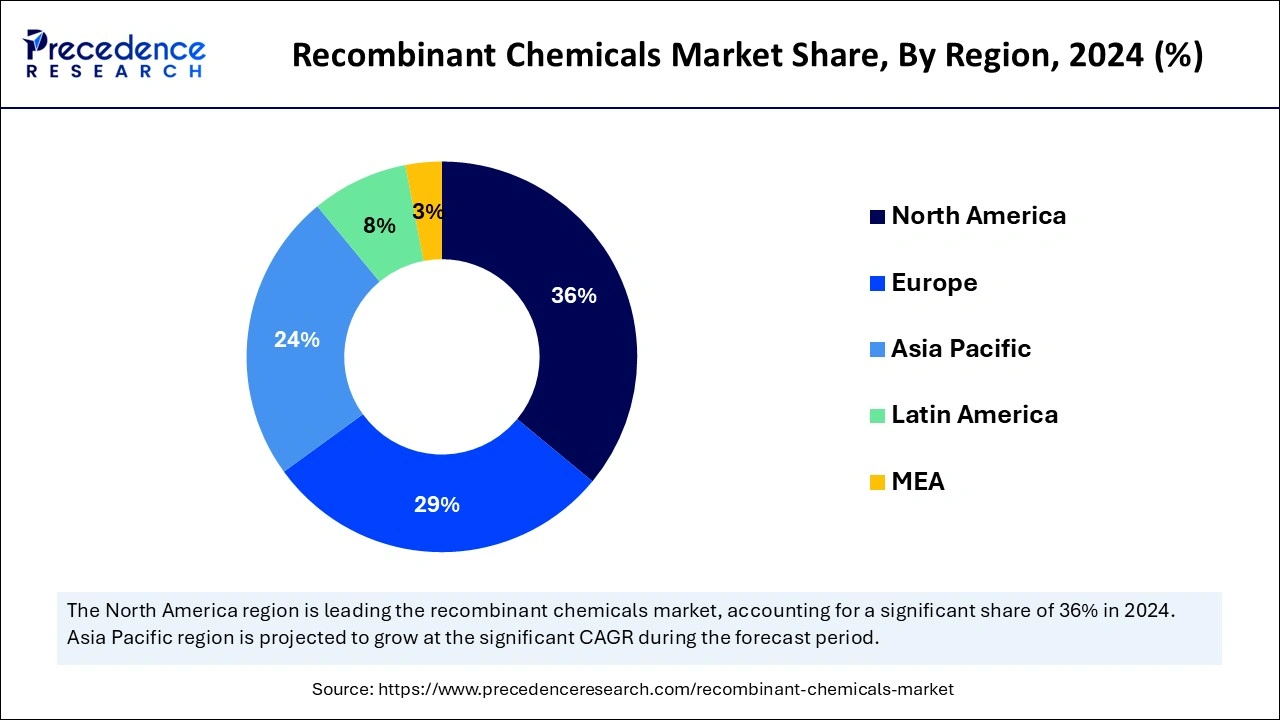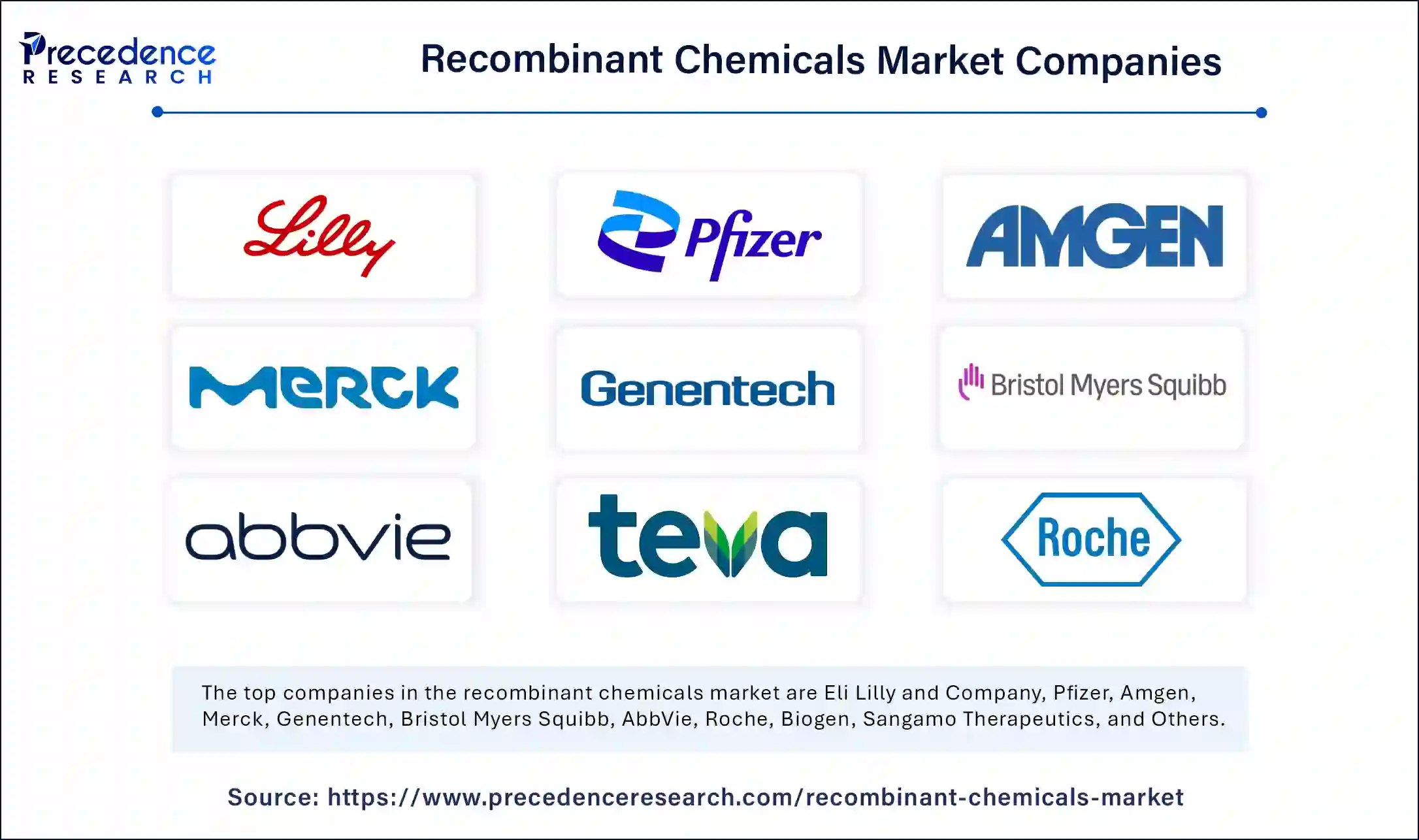January 2025
The global recombinant chemicals market size is evaluated at USD 19.10 billion in 2025 and is forecasted to hit around USD 27.95 billion by 2034, growing at a CAGR of 4.32% from 2025 to 2034. The North America market size was accounted at USD 6.59 billion in 2024 and is expanding at a CAGR of 4.46% during the forecast period. The market sizing and forecasts are revenue-based (USD Million/Billion), with 2024 as the base year.
The global recombinant chemicals market size accounted for USD 18.31 billion in 2024 and is predicted to increase from USD 19.10 billion in 2025 to approximately USD 27.95 billion by 2034, expanding at a CAGR of 4.32% from 2025 to 2034. The market is experiencing rapid growth due to innovations in biotechnology, the increasing need for biopharmaceuticals, sustainability initiatives, agricultural biotech expansion, personalized medicine, and waste management.

Advanced production systems incorporating automation technology with artificial intelligence make operations more efficient and less expensive while reducing human mistakes. A combination of progress in automation and artificial intelligence helps create a sustainable method for expanding the market. Automated design of DNA sequences using AI technology has brought faster operations while improving their accuracy levels. AI machine-learning technology analyzes extensive genetic data so researchers can create improved DNA sequences through pattern identification processes.
The U.S. recombinant chemicals market size was evaluated at USD 4.94 billion in 2024 and is projected to be worth around USD 7.70 billion by 2034, growing at a CAGR of 4.53% from 2025 to 2034.

North America dominated the recombinant chemicals market in 2024. The prominent market players, a rise in infectious and chronic illnesses, increased investment in development, a surge in genomics initiatives, and favorable government funding are all driving growth in this region. Furthermore, the United States holds a significant portion of the market owing to its advanced biotechnology sector, a regulatory environment that fosters innovation, and the presence of major pharmaceutical companies that are advancing pharmaceutical innovation and the use of recombinant chemical technologies, driven by the increasing prevalence of chronic illnesses such as cancer in the area.
The increasing technological progress in recombinant technology further enhances the expansion of the regional market. Moreover, the increasing government efforts to enhance research and development activities and create innovative therapeutic solutions for chronic disease treatment will further drive the growth of the regional market. Furthermore, robust support from government initiatives and a significant demand for biopharmaceuticals play a key role in acquiring North America’s dominant position in this market.

Asia Pacific is anticipated to witness the fastest growth in the recombinant chemicals market during the forecasted years. The rapid expansion in this area is driven by higher healthcare spending, an advancing biotech sector, and escalating investments in life sciences research due to the rapid development of the healthcare industry. Furthermore, the increasing investment in enhancing healthcare infrastructures also drives the expansion of the regional market.
The rising elderly population, coupled with the expanding disposable income of individuals in the area, will notably aid the growth of the regional market throughout the projected period. Nations such as China, Japan, and India are leading this expansion because of their growing pharmaceutical industries, supportive government regulations, and an increasing emphasis on precision medicine.
Recombinant chemicals develop from recombinant DNA technology, which enables scientists to transform genetic material artificially into specific proteins or enzymes. The commercial value of recombinant chemicals grows along with the expanding market demand for recombinant protein vaccines. A growing number of individuals diagnosed with genetic abnormalities is the primary driver behind the expanding recombinant chemicals market. The process of developing and improving vaccines relies exclusively on recombinant proteins.
Rising demand for biopharmaceuticals and increased requirements for sustainable manufacturing processes drive the growth of the market. The market continues to grow because recombinant chemicals power various diagnostic applications and treatments and assist drug research and development efforts. The popularity of recombinant chemicals continues to grow as genetic engineering techniques are advancing and producing innovative solutions throughout medical fields and agriculture production. The market's opportunities are rising rapidly, especially in the fields of precision therapeutics and customized medicine.
| Report Coverage | Details |
| Market Size by 2034 | USD 27.95 Billion |
| Market Size by 2025 | USD 19.10 Billion |
| Market Size in 2024 | USD 18.31 Billion |
| Market Growth Rate from 2025 to 2034 | CAGR of 4.32% |
| Leading Region | North America |
| Fastest Growing Market | Asia Pacific |
| Base Year | 2024 |
| Forecast Period | 2025 to 2034 |
| Segments Covered | Product Type, Technology, Application, and Regions |
| Regions Covered | North America, Europe, Asia-Pacific, Latin America, and Middle East & Africa |
Increasing demand for biopharmaceuticals
The recombinant chemicals market Industry realizes significant growth from increasing market demand for biopharmaceuticals. Biopharmaceutical solutions have become the preferred choice within the global healthcare sector because they excel at precise targets while delivering superior effectiveness. Recombinant chemicals delivered multiple advantages to agricultural systems through their part in bio-pesticide creation and genetic organism modification processes. The biotech industry's demand for recombinant enzymes keeps rising because these can produce environmentally sustainable and productive product-making processes from which industrial businesses can benefit.
The recombinant chemicals market witnesses an expanding demand across multiple sectors. The pharmaceutical industry is utilizing biotechnology-driven complex molecule manufacturing capabilities to produce therapeutic proteins together with vaccines. The market shows growing interest in recombinant enzymes since these enzymes enable eco-friendly production processes that run more efficiently in industrial applications. Increasing investment and innovation in recombinant chemical technology occur due to the expanding market potential needed for sustainable solutions and personalized medicine applications.
Complexity and cost challenges
In the recombination chemicals industry, there are several challenges to growth. For smaller companies, the medium of recombinant technology is very complex, and high manufacturing investment is very difficult to embrace. There are also very strong restrictions on the production and use of genetically altered products, leading to a very cumbersome and expensive amendment process. The market demand is also affected by the public and ethical issues surrounding genetic engineering. Apart from the lack of marketability, this also leads to a very slow and gradual growth of the recombinant chemicals market.
Growing usage in agriculture
The growing use of recombinant chemicals in farming to develop sustainable food production. With the help of recombinant technologies, it is possible to develop genetically modified organisms (GMOs) that can withstand pests, diseases, and even harsh environmental changes. In general, the use of 'recombinant chemicals" in agriculture refers to the production of chemicals using recombinant DNA technology, where the organisms are altered to produce new compounds with specific attributes, such as crops that are better able to survive attacks from insects, or diseases, or even environmental damage. This helps in increasing the productivity of crops while decreasing the usage of agricultural chemicals, which is ideal for sustainability objectives.
The recombinant DNA segment created the highest share of the recombinant chemicals market in 2024. Recombinant DNA Technology (RDT) enables the development of new drugs and vaccines that improve healthcare status. The growing technological demand stems from its capability to produce necessary proteins that sustain nutritional quality and prevent medical problems. Genetically modified organisms (GMOs) because urban population growth combined with global population expansion required scientists to create bio-degraders that produce clean fuel and fight arable land shortages and severe food shortages. The market continues to rise because GMO research has increased dramatically.
The recombinant protein segment is anticipated to witness the fastest growth in the recombinant chemicals market during the forecast period. The industry producing recombinant proteins experiences continuous growth by using genetic engineering to create proteins that serve medical needs and industrial purposes. The production of novel medical treatments at different stages of chronic illness development uses recombinant proteins. The advantages of recombinant proteins drive researchers to prefer them over natural proteins. Recombinant proteins enable high-level protein production that maintains a complete absence of animal-based substances.
The microbial expression systems segment created the highest share of the recombinant chemicals market in 2024. Recombinant proteins are chemicals generated through microbial expression systems. These systems are utilized to generate recombinant proteins for both research and industrial applications. Recombinant chemicals are substances generated by a microorganism utilizing a process termed "microbial expression," in which a gene that codes for the target chemical is integrated into the microbe's DNA. The particular microorganisms serve as hosts for the generation of these recombinant chemicals, with bacteria such as Escherichia coli (E. coli) being the most prevalent example, as they can be genetically altered to synthesize intricate molecules that they do not naturally produce.
The mammalian cell expression systems segment is anticipated to witness the fastest growth in the recombinant chemicals market during the forecast period. Mammalian cell expression utilizing recombinant substances is a method that employs chemical agents to insert DNA into mammalian cells. Recombinant proteins are most often expressed in mammalian cells as they are capable of performing post-translational modification and protein folding and secretion. Mammalian cell expression is a method that is used to formulate recombinant proteins with the aim of therapeutic and diagnostic use.
The drug development segment generated the highest share of the recombinant chemicals market in 2024. Recombinant chemicals are used in the creation of new drugs, basic diagnostic assays, therapeutic tools, and vaccine development in the pharmaceutical and medical fields. Recombinant DNA technology is used to generate proteins and chemicals through genetic engineering, which pharmaceutical companies use during their drug production process. The procedure uses genes extracted from one species to insert them into bacteria or yeast so the cells produce usable drug proteins. Research laboratories create recombinant chemicals through the laboratory combination of genetic material extracted from different organisms. The creation of proteins and gene-based therapeutics implements this process during drug development.
The vaccine production segment is projected to witness the fastest growth in the recombinant chemicals market during the forecast period. This growth is a response to global public health issues, so the health market is growing, and vaccine demand is increasing. There is a more diverse set of diseases that need a vaccine, and the surge in popularity of personalized and gene-based vaccines is one of the reasons for the rising demand for recombinant chemicals. Biotechnology developments that improve the effectiveness and efficiency of vaccine production also contribute to this growth, making the vaccine manufacturing industry one of the main drivers.

By Product Type
By Technology
By Application
By Geography
For inquiries regarding discounts, bulk purchases, or customization requests, please contact us at sales@precedenceresearch.com
No cookie-cutter, only authentic analysis – take the 1st step to become a Precedence Research client
January 2025
January 2025
January 2025
May 2024